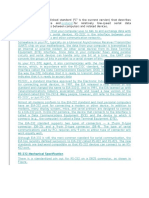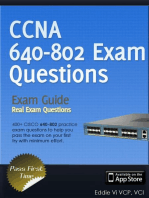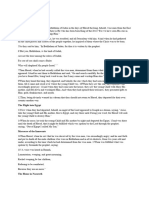Signals
Signals
Uploaded by
Rytis UrbonavičiusCopyright:
Available Formats
Signals
Signals
Uploaded by
Rytis UrbonavičiusCopyright
Available Formats
Share this document
Did you find this document useful?
Is this content inappropriate?
Copyright:
Available Formats
Signals
Signals
Uploaded by
Rytis UrbonavičiusCopyright:
Available Formats
CA: Request To Send On this line, the DTE will send a signal when it wants to receive data from
the DCE. CB: Clear To Send Here the DCE will send a signal when it's ready to receive data from the DTE. (ex. When your local modem connects to an other modem via telephone lines). CC: Data Set Ready At a logical level of 1, this line indicates to the DTE that the DCE is ready to send data. (ex. When a modem has established a connection with a remote modem and is in transmission mode). CD: Data Terminal Ready When a logical level 1 is sent from the DTE the DCE can start to send and receive data. When this line passes to logical level 0 the DCE will stop all communications. (ex. A modem would stop all communications and would disconnect from the line, you will often see "DROP DTR" in communication programs). CF: Data Carrier Detect On this line the DCE indicates to the DTE that it has established a carrier with a remote device. CE: Ring Indicator This line is used mostly by communications software when the modem is not in "auto answer" mode and will indicate to the the software that a remote device is calling. This is signal is optional when not using software that will answer a phone call automatically. CG: Signal quality This line although rarely used serves to indicate to the DTE that the quality of the signal is poor or just not good enough to keep a good connection. CH: Data signal rate selector In the case where a modem able of multiple connection rates, the DTE could choose the speed at which it is connected. Usually this line is kept a logical level 0 which selects the highest speed. CI: Data signal rate selector This signal is the same as CH but in this case the modem selects the speed at which the DTE communicates. 25pin 1 2 3 4 5 6 7 8 9 10 11 12 13 14 15 16 17 18 19 20 21 22 23 24 25 9 pin TXD RXD RTS CTS DSR GND CD 3 2 7 8 6 5 1 DCE Direction x Protective Ground I Transmitted Data O Received Data I Request to Send O Clear to Send O Data Set Ready x Signal Ground O Received Line Signal Detector x Reserved for Data set Testing x Ditto x Unassigned O Secondary Received Line Signal Detector O Secondary Clear to send I Secondary Transmitted Data O Transmission Signal Element Timing (DTE Source) O Secondary Received Data O Receiver Signal Element Timing (DCE Source) x Unassigned I Secondary Request to Send CD I Data Terminal Ready O Signal Quality Detector CE O Ring Indicator I/O Data Signal Rate Selector (DTE/DCE Source) I Transmit Signal Element Timing (DTE Source) x Unassigned AA BA BB CA CB CC AB CF ---
SCF SCB SBA DB SBB DD SCA DTR CG CH/CI DA 4 9
How to wire a Nullmodem cable 25pin 9pin 9p 25p FG 1 X 1 FG TD 2 3 2 3 RD RD 3 2 3 2 TD RTS 4 7 8 5 CTS CTS 5 8 7 4 RTS SG 7 5 5 7 SG DSR 6 6 4 20 DTR DTR 20 4 6 6 DSR ---------------------------------------------------------------------Frame Ground Transmit Data Receive Data Request To Send Clear To Send Signal Ground Data Set Ready Data Terminal Ready
RS-232 in Cisco IOS
The Cisco IOS variation of asynchronous RS-232 is shown in Figure 4-3. The variation exists between the Cisco IOS line (DTE) and the NAS modem (DCE). Six RS-232 pins exist between each NAS modem and Cisco IOS line. One or more grounding wires also exist on physical RS-232 lines; however, these wires do not convey signaling. Each pin controls a different RS-232 signal. The arrows in Figure 4-3 indicate the signal transmission direction.
Figure 4-3: Cisco IOS RS-232 Tips In Figure 4-3, notice that the DSR signal is the DCD signal for the modem. In the scheme of Cisco IOS, the DCD pin on the DCE is strapped to the DSR pin on the Cisco IOS DTE side. What the Cisco IOS calls DSR is not DSR; it is DCD. The DCE's actual DSR pin and ring ignore (RI) pin are ignored by the Cisco IOS. Table 4-1 describes how Cisco uses it's RS-232 pins. The signal direction in the table is from the perspective of the DTE (IOS line): Data signals (TxD, RxD) Hardware flow control signals (RTS, CTS) Modem signals (DTR, DSR, DCD, RI) Table 4-1: RS-232 Signal Signal Purpose State Behavior Signal Direction ------> Transmit Data (TxD) DTE transmits data to DCE. (Output) <-----Receive Data (RxD) DCE transmits received data to DTE. (Input) DTE uses the RTS output signal to indicate if it can receive ------> characters into the Rx input buffer1. Request To Send (RTS) (Output) The DCE should not send data to the DTE when DTR input is low (no RTS). DCE signals to DTE that it can continue to accept data into its <-----Clear To Send (CTS) buffers. (Input) DCE asserts CTS only if the DCE is able to accept data. DTE signals to DCE that it can continue to accept data into its ------> Data Terminal Ready (DTR) buffers. (Output) DTE asserts RTS only if the DTE is able to accept data. DCE indicates to DTE that a call is established with a remote <-----modem. Dropping DCD terminates the session. Data Carrier Detect (DCD) (Input) DCD will be up on the DCE only if the DCE has achieved data mode with its peer DCE (client modem).
1
The name RTS is illogical with the function (able to receive) due to historical reasons.
You might also like
- From GSM to LTE-Advanced Pro and 5G: An Introduction to Mobile Networks and Mobile BroadbandFrom EverandFrom GSM to LTE-Advanced Pro and 5G: An Introduction to Mobile Networks and Mobile BroadbandNo ratings yet
- Communication Skills Lab Practice Manual (For Polytechnics) - Diploma 4th SemesterDocument53 pagesCommunication Skills Lab Practice Manual (For Polytechnics) - Diploma 4th SemesterRaja Ramesh86% (7)
- Rs 232 TutorialDocument7 pagesRs 232 Tutorialapi-26695410100% (1)
- An Introduction To Serial Port InterfacingDocument25 pagesAn Introduction To Serial Port InterfacingAyushi GuptaNo ratings yet
- RS232 Data Interface: A TutorialDocument25 pagesRS232 Data Interface: A TutorialMr. SCIFINo ratings yet
- Assignment 3Document3 pagesAssignment 3Nutan NiraulaNo ratings yet
- WaterLog RS 232 Communications Technical NoteDocument5 pagesWaterLog RS 232 Communications Technical NoteEng-ahmed ismail -مهندس كهرباءNo ratings yet
- RS232 Data Interface: A TutorialDocument23 pagesRS232 Data Interface: A TutorialvinothvlbNo ratings yet
- What Is RS232 PDFDocument4 pagesWhat Is RS232 PDFtjiangtjiangs100% (1)
- Rs232 Serial CommunicationDocument4 pagesRs232 Serial CommunicationJuan Diaz100% (1)
- Rs-232 Interface: Computer TerminalDocument4 pagesRs-232 Interface: Computer TerminalJames MojicaNo ratings yet
- DB9 To DB25Document3 pagesDB9 To DB25Bayu WiroNo ratings yet
- Application Note: App. Note Number: 1003 Title: RS-232 CommunicationsDocument11 pagesApplication Note: App. Note Number: 1003 Title: RS-232 CommunicationsRamya VkNo ratings yet
- Data Communication Over Telephone LinesDocument3 pagesData Communication Over Telephone LinesAnand Asia100% (1)
- Serial Interfaces: RS-232 InterfaceDocument3 pagesSerial Interfaces: RS-232 InterfaceIgnacio CatalanNo ratings yet
- Tech Serial v1r0c0 PDFDocument15 pagesTech Serial v1r0c0 PDFsalehimohsen13514969100% (1)
- Data Communication and Networking (Lab Manual)Document62 pagesData Communication and Networking (Lab Manual)Abhishek Pattanaik100% (1)
- DCT 03 Exp 01 Db9 ConnectorDocument4 pagesDCT 03 Exp 01 Db9 ConnectorGia TríNo ratings yet
- Pengantar RS232Document26 pagesPengantar RS232beben honNo ratings yet
- Industrial Data CommunicationDocument73 pagesIndustrial Data CommunicationHaider Ali Abbasi100% (2)
- History and Theory of Serial CommunicationsDocument18 pagesHistory and Theory of Serial Communicationscam894No ratings yet
- RS449 37 Pin PinoutDocument4 pagesRS449 37 Pin PinoutAbhishek KumarNo ratings yet
- PC 2 PCDocument8 pagesPC 2 PCfactotum90No ratings yet
- Serial Interfaces: RS-232 InterfaceDocument3 pagesSerial Interfaces: RS-232 InterfacejkmaroNo ratings yet
- 06 - Wan1 - X25Document27 pages06 - Wan1 - X25Socaciu VioricaNo ratings yet
- COS10004 Lecture 6.1 Data CommunicationDocument26 pagesCOS10004 Lecture 6.1 Data CommunicationHồ Thành AnNo ratings yet
- Serial CommunicationDocument8 pagesSerial CommunicationKrisHnA 2kNo ratings yet
- 8051 CoomunicationDocument93 pages8051 CoomunicationjaigodaraNo ratings yet
- SERIAL - PORTDocument17 pagesSERIAL - PORTaamirraihanNo ratings yet
- The Data Communications InterfaceDocument38 pagesThe Data Communications InterfaceAvani PatelNo ratings yet
- Interfacing The SerialDocument19 pagesInterfacing The SerialNaveed Asif100% (1)
- RS232 Cable Pinouts - Quick TipsDocument3 pagesRS232 Cable Pinouts - Quick TipsstudskirbyNo ratings yet
- RS232 StandardsDocument10 pagesRS232 Standardsarsenaldo100% (1)
- RS232 To RS422 Converter ConfigurationDocument5 pagesRS232 To RS422 Converter ConfigurationDavid AldanaNo ratings yet
- RS232 InterfaceDocument3 pagesRS232 Interfacevairam81No ratings yet
- Lecture 2Document29 pagesLecture 2Vinitha ViswanathanNo ratings yet
- RS232 Wiring DiagramsDocument14 pagesRS232 Wiring DiagramsIsmail KırbaşNo ratings yet
- Ethernut RS-232 Primer: HardwareDocument12 pagesEthernut RS-232 Primer: HardwarearsenaldoNo ratings yet
- AN83 Maxim Fundamentals of RS-232 Serial CommunicationsDocument9 pagesAN83 Maxim Fundamentals of RS-232 Serial CommunicationsCarlos Roman Zarza100% (1)
- CCM RS232 Cable Wire ConnectionDocument2 pagesCCM RS232 Cable Wire Connectionlinkangjun0621No ratings yet
- T17 Interfaces: Chapter - 6Document7 pagesT17 Interfaces: Chapter - 6lvsaruNo ratings yet
- 8051 CH10Document93 pages8051 CH10Murali KrishnaNo ratings yet
- Serial Port Communication LabviewDocument5 pagesSerial Port Communication Labviewpj_bank100% (2)
- Rs 232Document16 pagesRs 232Nadeem YasirNo ratings yet
- Electronic Instrumentation and MeasurementsDocument76 pagesElectronic Instrumentation and MeasurementsSiswoyo SuwidjiNo ratings yet
- Rs 232Document25 pagesRs 232sindhu10689No ratings yet
- Interface Design Serial CommunicationsDocument37 pagesInterface Design Serial CommunicationskhsniperNo ratings yet
- CAR ProtocolDocument16 pagesCAR ProtocolThulasi ram AchariNo ratings yet
- Protocol: RS-232 Mechanical SpecificationDocument4 pagesProtocol: RS-232 Mechanical SpecificationAashutosh TiwariNo ratings yet
- 8251 UsartDocument14 pages8251 Usartmohit mishraNo ratings yet
- Serial Communication Via RS232 Port:: Download Example Source CodeDocument7 pagesSerial Communication Via RS232 Port:: Download Example Source Codesigids100% (2)
- SSE Training Module 2Document106 pagesSSE Training Module 2bjorn schubertNo ratings yet
- CISCO PACKET TRACER LABS: Best practice of configuring or troubleshooting NetworkFrom EverandCISCO PACKET TRACER LABS: Best practice of configuring or troubleshooting NetworkNo ratings yet
- WAN TECHNOLOGY FRAME-RELAY: An Expert's Handbook of Navigating Frame Relay NetworksFrom EverandWAN TECHNOLOGY FRAME-RELAY: An Expert's Handbook of Navigating Frame Relay NetworksNo ratings yet
- PLC: Programmable Logic Controller – Arktika.: EXPERIMENTAL PRODUCT BASED ON CPLD.From EverandPLC: Programmable Logic Controller – Arktika.: EXPERIMENTAL PRODUCT BASED ON CPLD.No ratings yet
- Network with Practical Labs Configuration: Step by Step configuration of Router and Switch configurationFrom EverandNetwork with Practical Labs Configuration: Step by Step configuration of Router and Switch configurationNo ratings yet
- Digital Mobile Communications and the TETRA SystemFrom EverandDigital Mobile Communications and the TETRA SystemRating: 5 out of 5 stars5/5 (1)
- Times New Roman Size 18 Bold (Activity Sheets in Subject Grade Level Quarter Number, Week Number)Document4 pagesTimes New Roman Size 18 Bold (Activity Sheets in Subject Grade Level Quarter Number, Week Number)Krissa FriasNo ratings yet
- Poly X50Document4 pagesPoly X50Harsono WibowoNo ratings yet
- Kabankalan Catholic CollegeDocument11 pagesKabankalan Catholic CollegeChezkie EmiaNo ratings yet
- 1ga S4hana2020 BPD en RoDocument48 pages1ga S4hana2020 BPD en RoSuta100% (1)
- Creating A View in ClearcaseDocument13 pagesCreating A View in Clearcaseprem_09No ratings yet
- Aula 03 - Word e WriterDocument30 pagesAula 03 - Word e WriterAndréNo ratings yet
- B1 Grammar - Question TagsDocument4 pagesB1 Grammar - Question TagsSamer dawanNo ratings yet
- RHGP Mod 3Document12 pagesRHGP Mod 3jeraldbabacNo ratings yet
- ECS&EDocument7 pagesECS&EAmara AfreenNo ratings yet
- Islamiyat Test Week 2 Notes CREDIT MIKAEL ATIFDocument7 pagesIslamiyat Test Week 2 Notes CREDIT MIKAEL ATIFshahmeerraheel123No ratings yet
- Australia - Worksheet With QuestionsDocument2 pagesAustralia - Worksheet With QuestionsAskold ShymanskiNo ratings yet
- Book of Job Thesis StatementDocument8 pagesBook of Job Thesis Statementtracywilliamssalem100% (2)
- Detailed Lesson Plan (DLP) Format: Learning Competency/ies: Code: EN8RC-Ii-7Document1 pageDetailed Lesson Plan (DLP) Format: Learning Competency/ies: Code: EN8RC-Ii-7Jeraldine RepolloNo ratings yet
- Face2Face Pre Intermedate Second Edition 6A Lesson PlanDocument2 pagesFace2Face Pre Intermedate Second Edition 6A Lesson PlanAli SallakNo ratings yet
- Alexander Afanasyev - WikipediaDocument3 pagesAlexander Afanasyev - WikipediaMd Intaj AliNo ratings yet
- Woo, I. H. (2013) - The Syntax of The Aspectual Particles in Mandarin ChineseDocument273 pagesWoo, I. H. (2013) - The Syntax of The Aspectual Particles in Mandarin ChineseJulio YangNo ratings yet
- Point of View UnitDocument14 pagesPoint of View Unitstevekinney100% (8)
- Lutheran Church of Central AfricaDocument3 pagesLutheran Church of Central Africanovascotta343No ratings yet
- The Availability of Universal Grammar To Second LaDocument11 pagesThe Availability of Universal Grammar To Second LaZuriñe Frías CobiánNo ratings yet
- Matthew 2Document2 pagesMatthew 2Lady Paul SyNo ratings yet
- ITT542 - Case Study 1 Network Layer Protocol ORIDocument10 pagesITT542 - Case Study 1 Network Layer Protocol ORIAhmad KamalNo ratings yet
- Holy Rosary October 2021Document45 pagesHoly Rosary October 2021Jayron PilanteNo ratings yet
- Materials Management Solution GuideDocument75 pagesMaterials Management Solution GuideErdal TekinNo ratings yet
- Flow Chart RulesDocument2 pagesFlow Chart RulesNiamul Islam RimonNo ratings yet
- A Detailed Lesson Plan in English 4: Teacher's Activity Pupil's ActivityDocument6 pagesA Detailed Lesson Plan in English 4: Teacher's Activity Pupil's ActivityMaureen Canlobo PunzalanNo ratings yet
- Bellman EquationDocument13 pagesBellman EquationsurajdhunnaNo ratings yet
- English Form 3 Scheme of Work 2016Document8 pagesEnglish Form 3 Scheme of Work 2016jayavesovalingamNo ratings yet
- New Generation Literary Theory 5Document144 pagesNew Generation Literary Theory 5Dati OkonNo ratings yet
- Wh-Questions + Simple PresentDocument15 pagesWh-Questions + Simple PresentCarlos SilvaNo ratings yet

























































































